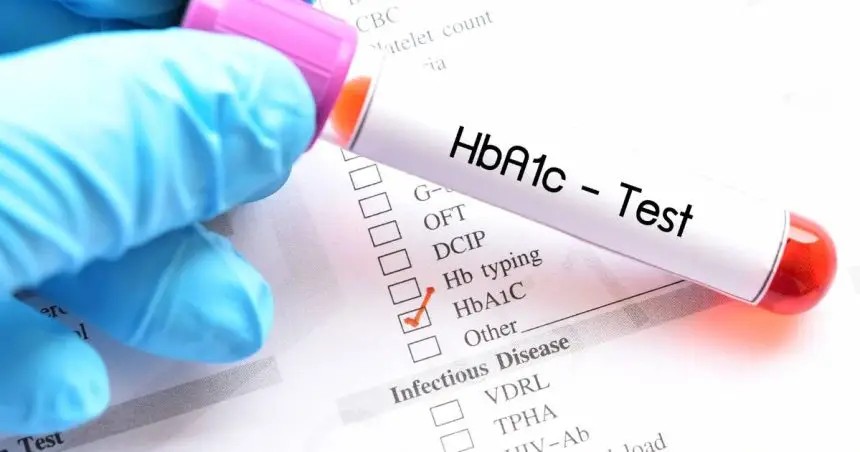A glycated hemoglobin A1c check (HbA1c), or just A1c check, measures your common blood sugar degree over the previous two to a few months.
It is a customary check that diabetics endure periodically to evaluate how nicely they’re controlling their blood sugar ranges and to make any needed changes to their remedy plan.
So what’s a harmful degree of A1c? On this article, we discover A1c ranges which might be thought-about too low or too excessive, and focus on methods to enhance them if they’re thought-about harmful.
What’s A1c?
A1c measures the typical quantity of glucose sure to hemoglobin in crimson blood cells over the previous two to a few months.
Hemoglobin is the protein that offers blood its crimson shade and is important for transporting oxygen all through the physique and sustaining well being.
Purple blood cells regenerate roughly each three months, so your A1c check displays your common blood sugar ranges over this era.
Outcomes are often extra influenced by blood sugar ranges within the weeks instantly previous the check.
See beneath for extra info. Find out how to decrease your A1c: The entire information and Find out how to decrease A1c naturally.
What’s the distinction between A1c ranges?
The American Diabetes Affiliation classifies A1c ranges to establish diabetes administration standing:
- Regular (non-diabetic): A1c lower than 5.7 p.c
- Prediabetes: A1c between 5.7 p.c and 6.4 p.c
- Diabetes: A1c 6.5% or greater
Your private A1c purpose will rely in your private well being. For instance, a better A1c could also be really helpful for individuals who dwell alone or who’ve issue detecting low blood sugar ranges (a situation referred to as silent hypoglycemia).
For pregnant ladies with diabetes, preserve A1c as shut to six% as safely achievable to reduce the danger of problems throughout being pregnant, so long as tight management doesn’t end in frequent hypoglycemia (hypoglycemia). It’s typically really helpful to take action.
The ADA recommends that adults preserve an A1c beneath 7% to forestall problems related to diabetes, whereas kids ought to intention for an A1c beneath 7.5%.
What’s a harmful A1c degree?
Managing A1c ranges is vital as each excessive and low ranges carry important well being dangers. It is important to work along with your physician to find out your superb A1c goal, which can differ relying in your way of life, well being objectives, and life stage.
See beneath for extra info. Blood Sugar Chart: Blood Sugar Degree and A1c Goal.
A1c lower than 5%
Though it’s uncommon and commendable for a diabetic to have an A1c beneath 5%, ranges beneath 5% could point out frequent hypoglycemia.
This example is very regarding for older folks, individuals who dwell alone, or when low blood sugar ranges are troublesome to detect.
In these situations, the implications of hypoglycemia might be extra harmful and may result in extreme outcomes corresponding to diabetic coma and dying.
In case you expertise frequent hypoglycemia, you will need to focus on along with your physician the potential for adjusting your insulin dosage to maintain your A1c at a safer degree with out frequent hypoglycemia.
You will need to be aware that individuals with newly recognized sort 1 diabetes could briefly exhibit very low A1c ranges throughout a interval referred to as the “honeymoon interval.” This era happens whereas the pancreas continues to be producing some insulin.
A1c larger than 7%
The ADA recommends that almost all adults intention to maintain their A1c beneath 7% to forestall diabetes-related problems. For kids, the purpose is often set at lower than 7 to 7.5 p.c, relying on the person’s circumstances, reflecting the necessity to steadiness glycemic management with the danger of hypoglycemia.
Nonetheless, successfully managing diabetes might be troublesome resulting from a wide range of way of life elements. An A1c of seven p.c to eight p.c is above the best purpose, however doesn’t instantly trigger problems.
Nonetheless, you will need to intention for decrease ranges to cut back the long-term danger of diabetes-related well being issues.
A1c larger than 9%
Above 9%, the danger of extreme diabetes problems corresponding to coronary heart illness, nerve harm, and kidney failure will increase considerably. Because the A1c proportion will increase, the danger continues to extend.
Chart from A1c to eAG
Beneath are A1c ranges relative to estimated common blood glucose (eAG) ranges.
| A1c | eAG |
| 9 p.c | 212 mg/dL (11.77 mmol/L) |
| 10 p.c | 240mg/dL (13.32mmol/L) |
| 11 p.c | 269 mg/dL (14.93 mmol/L) |
| 12 p.c | 298 mg/dL (16.54 mmol/L) |
| 13 p.c | 326 mg/dL (18.09 mmol/L) |
| 14 p.c | 355 mg/dL (19.70 mmol/L) |
See beneath for extra info. Find out how to convert A1c to blood sugar degree.
Managing A1c variation
When you have excessive A1c ranges, contemplate discussing methods along with your well being care supplier to regulate your drugs, weight-reduction plan, and train routine. Addressing underlying psychological well being points might also be useful.
Observe: Particularly in sort 1 diabetes, A1c ranges might be very excessive on the time of prognosis. Nonetheless, these ranges often decline quickly with efficient insulin remedy, decreasing the danger of long-term problems.
Find out how to make A1c safer
In case you’re approaching harmful ranges, it is vital to regulate your A1c, whether or not by rising it or reducing it. This is the way to handle your A1c safely.
In case your A1c is just too low:
- Please seek the advice of your well being care supplier. Focus on the potential for decreasing your medicine or insulin dosage to keep away from frequent hypoglycemia.
- Get some train. If bodily exercise causes hypoglycemia, contemplate decreasing the depth or length of your coaching.
- Alter your weight-reduction plan. Growing your protein and fats consumption might help stabilize your blood sugar ranges, particularly at night time.
- Please use Steady Glucose Monitor (CGM)): Utilizing CGM, hypoglycemia might be detected earlier than it turns into vital, permitting for well timed intervention.
- Optimize your insulin pump settings. In case you use an insulin pump, briefly modify your basal insulin dose for actions that decrease blood sugar ranges, corresponding to train, to forestall hypoglycemia.
These methods assist preserve blood sugar ranges at secure ranges and decrease the danger of each excessive and low blood sugar ranges.
If A1c is just too excessive
- Please seek the advice of your physician. Work along with your well being care supplier to regulate your medicine and insulin doses to raised handle your blood sugar ranges.
- Improve bodily exercise: Incorporate extra bodily exercise into your each day life to decrease your blood sugar ranges.
- Eat a balanced weight-reduction plan: Give attention to a low-carbohydrate weight-reduction plan and embrace loads of fiber-rich entire meals. Keep away from processed meals and people with added sugar.
- Monitor your carbohydrates. When you have hassle counting carbs, hold a meals diary and search steering from a registered dietitian (RD/RDN) on meal planning.
- Monitor blood sugar ranges. Verify your blood sugar ranges a number of instances a day or use a CGM to detect excessive blood sugar ranges early.
- Optimize your insulin pump settings. In case you use an insulin pump, modify your basal price all through the day and night time to forestall extended hyperglycemia.
- prioritize sleep: To enhance insulin sensitivity, intention for 7 to 9 hours of sleep every night time.
- administration stress: Follow stress-reducing actions like yoga, meditation, and deep respiratory workout routines to cut back insulin resistance.
For extra info on the way to decrease your A1c, watch this video by Christel Oerum, founding father of Diabetes Sturdy. Within the video, she explains how she efficiently lowered her A1c to five.7 p.c in 30 days by following 5 easy steps.
What’s the significance of A1c?
A1c check helps diagnose diabetes
The A1c check is essential in diagnosing sort 1 and kind 2 diabetes, prediabetes, and in some instances gestational diabetes.
Analysis and monitoring
In case your outcomes point out prediabetes, your physician could advocate repeating your A1c check yearly or each six months. The Facilities for Illness Management and Prevention (CDC) recommends common screening for folks age 45 and older.
If the outcomes are regular, your physician will schedule a check primarily based in your age and danger elements. In case your check reveals prediabetes, you could want an A1c check each 1 to 2 years.
Figuring out danger elements
A1c testing is really helpful for folks underneath the age of 45 with sure danger elements for diabetes. These danger elements embrace:
- being chubby
- Have a household historical past of diabetes
- Hypertension (hypertension)
- Have had gestational diabetes up to now
- belong to an ethnic minority
- have coronary heart illness
- lead a sedentary way of life
diabetes signs
When you have not been recognized with diabetes however expertise any of the next signs, contact your physician instantly.
Relying on the severity, you could want an A1c check or emergency medical care.
check at dwelling
A1c check kits are additionally accessible for dwelling use and might be bought at your native pharmacy or on-line for handy monitoring.
For extra info, see: Find out how to measure A1c at dwelling.
A1c check determines basic diabetes management
For folks with diabetes, A1c testing is often executed quarterly to watch common blood sugar ranges and general diabetes administration over the previous three months.
The A1c check is efficient in figuring out whether or not your blood sugar ranges are persistently excessive or low and might help forestall problems corresponding to coronary heart illness, retinopathy, neuropathy (nerve harm), kidney illness, and untimely dying. Helps modify diabetes remedy.
Nonetheless, it is vital to do not forget that the A1c check provides you a median of your blood sugar ranges over the previous three months.
This averaging can masks fluctuations and provides a false sense of management in case your blood sugar ranges fluctuate incessantly between excessive and low values.
Nonetheless, in case your blood sugar ranges are comparatively steady, an A1c check can precisely replicate how nicely you’re protecting your blood sugar ranges inside your required vary.
Key factors for safely managing A1c
Whereas the risks of excessive A1c ranges are emphasised, the dangers of low A1c ranges are sometimes ignored. A secure A1c vary for most individuals is often between 5 and eight p.c, however this depends upon your particular person scenario.
Pregnant ladies might have a decrease A1c, whereas those that dwell alone or endure from hypoglycemia might have greater objectives.
An A1c of lower than 5% could point out frequent and extreme hypoglycemia. Conversely, in case your A1c is 9% or greater, your danger of diabetic problems will increase considerably.
To attain a secure A1c, work along with your well being care supplier to regulate your drugs, weight-reduction plan, bodily exercise, and handle your sleep and stress. There isn’t a “good” A1c, however protecting ranges inside a secure vary is vital to your well being and well-being.
Study extra about sustaining wholesome A1c ranges. Find out how to decrease your A1c: The entire information and Find out how to decrease A1c naturally. Was this text useful? Tell us by clicking Sure or No beneath.










